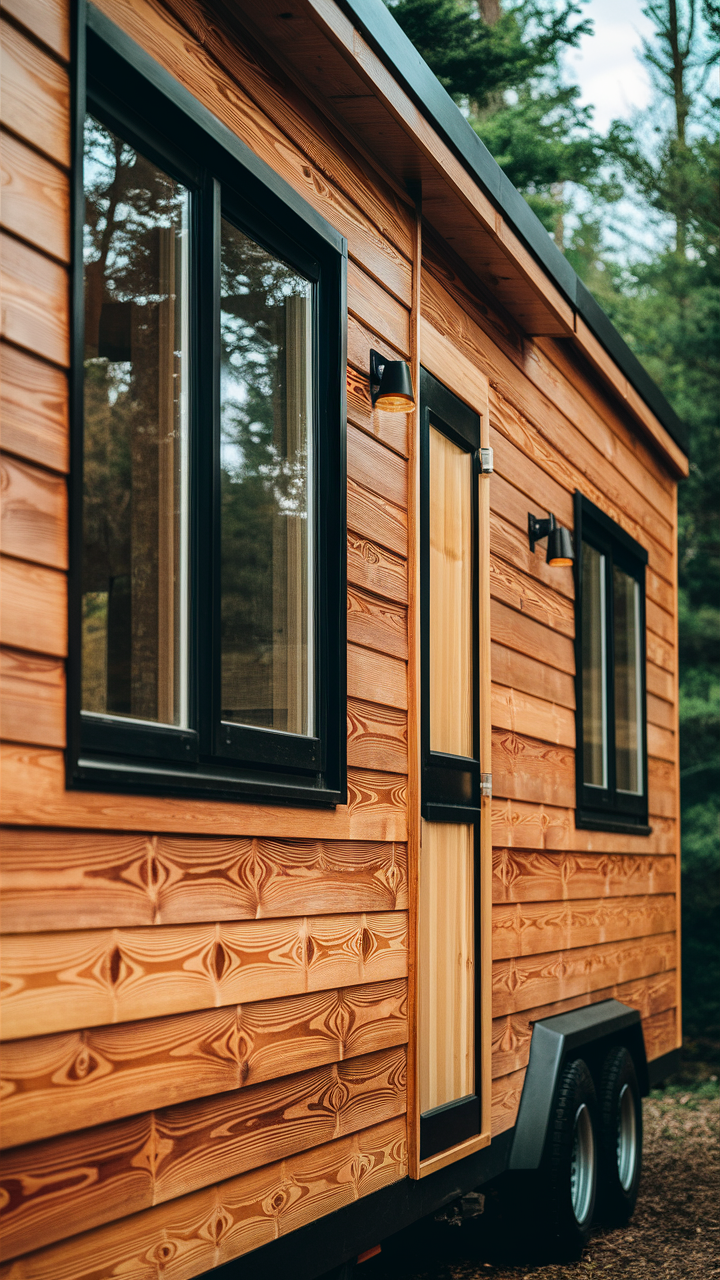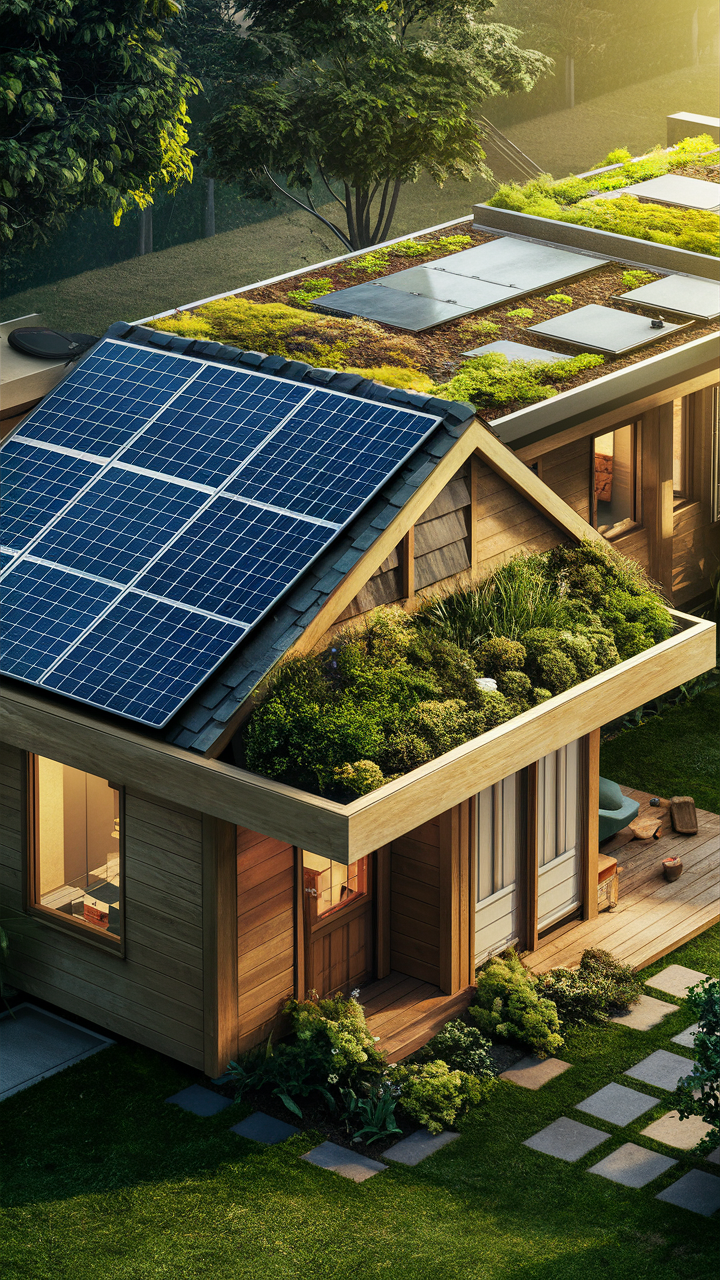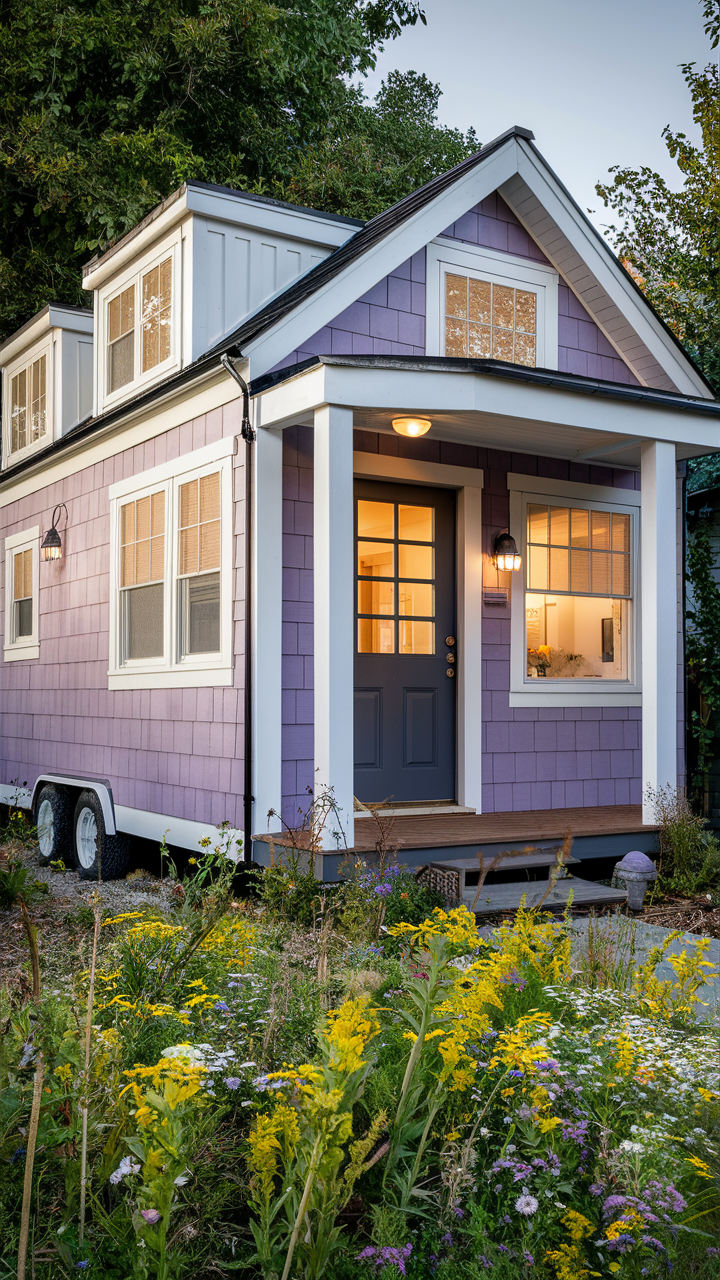Introduction
The design of a tiny home exterior plays a critical role in balancing aesthetics with functionality, which is vital for those choosing to live in a tiny space. The exterior isn’t just the face of your home; it reflects your personal taste and the functional needs of tiny house living. With the right siding, such as durable vinyl or naturally beautiful cedar, homeowners can achieve a look that is both stylish and sustainable. Incorporating eye-catching tiny house exterior features can also greatly enhance the curb appeal of your tiny home, making it not only a comfortable place to live but also a striking architectural statement.
When planning your tiny house design, it’s essential to consider how home exterior design ideas can maximize both form and function. Whether opting for a traditional home look with wood siding or a more modern approach with corrugate materials, each choice should support your lifestyle while ensuring the home’s design complements its surroundings. Exterior design choices like using sleek, prefab panels or stain treatments not only add character but also offer practical benefits like improved energy efficiency and reduced footprint, which are fundamental aspects of living in a tiny home.
Key Takeaways
- Tiny home exterior design is crucial for achieving both aesthetic appeal and functionality in small living spaces.
- Using durable materials like vinyl and cedar for siding ensures both style and sustainability.
- Eye-catching tiny house exterior features significantly enhance the curb appeal and make tiny homes both comfortable and visually striking.
- Planning tiny house design involves making choices that support a lifestyle while complementing the environment, utilizing materials like wood siding and corrugate.
- Exterior design choices should aim to improve energy efficiency and reduce the environmental footprint of tiny homes.
- Engaging with professionals through consultations and carefully selecting materials are key steps in successfully executing a tiny house exterior project.
Essentials of Tiny House Exterior Design

When planning the exterior of a tiny house, striking the right balance between aesthetics and functionality is crucial. Tiny houses are more than just spaces for minimalist living; they are about creating visually appealing homes within limited areas. Choosing the right exterior materials, such as vinyl and cedar, ensures both durability and style, making them perfect for enhancing the home design of a tiny dwelling. Siding is a great choice that looks great and offers longevity, ideally suiting the unique needs of living in a tiny house.
Best Materials for Tiny House Exteriors
| Material | Benefits | Considerations |
|---|---|---|
| Cedar Wood | Natural beauty, lightweight, and weather-resistant; enhances connection with nature. | Requires regular maintenance to prevent damage. |
| Metal Siding | Durable, low maintenance, and provides modern aesthetics; ideal for energy efficiency. | May dent or rust if not maintained; higher cost. |
| Vinyl Siding | Cost-effective, variety of styles, minimal upkeep; can mimic wood or stone. | Less appealing to some; can be damaged by extreme conditions. |
| Composite Materials | Durable, low-maintenance, often comes pre-finished; can mimic traditional wood. | Generally more expensive but offers long-term benefits. |
This table synthesizes findings from multiple sources which highlight the popularity and advantages of various siding materials such as cedar, metal, and vinyl for tiny houses. Each material offers unique benefits and comes with certain considerations, making them suitable for different styles and functional requirements of tiny house exteriors
Choosing the Right Siding Materials
Selecting the right siding materials is crucial for any tiny house, as it impacts not just the appearance but also the longevity and upkeep of the home. Vinyl siding is a popular choice due to its durability, low maintenance, and variety of color options, making it a great option for those looking to maintain an attractive home with minimal effort. Additionally, materials like cedar offer a classic look and can be a classic choice for tiny homes, providing natural beauty and resistance to weathering.
Design Strategies for Small Spaces
To effectively utilize the limited space in a tiny house, exterior design strategies should focus on maximizing openness and light. Large windows and smart use of color can make these small spaces feel larger and more welcoming. These design choices not only improve the aesthetic but also enhance the functionality of the living space, bringing in natural light and creating an illusion of a bigger area, which can greatly influence the home feel and overall interior design.
Maximizing Function in Tiny House Exteriors

The functionality of your tiny home’s exterior is crucial for ensuring a comfortable and sustainable living environment. Selecting appropriate materials and designs can greatly enhance your home’s energy efficiency and durability. This thoughtful approach ensures that your tiny house remains both practical and resilient, ideally tailored to the unique lifestyle of living in a tiny house. Such decisions keep the home feeling innovative and intimately connected to your needs, incorporating elements like loft bedroom designs and different materials to optimize space and comfort.
-
Use of High-Performance Insulation: Effective insulation is crucial for energy efficiency. Options like SIPs (Structural Insulated Panels) offer superior insulation properties and quick installation benefits, which are essential in maintaining optimal indoor temperatures and reducing energy costs.
-
Green Roofing Systems: Installing a green roof can provide excellent insulation, reduce stormwater runoff, and enhance the aesthetic and ecological value of your home. This option not only supports biodiversity but also contributes to thermal regulation within the house.
-
Solar Power Integration: Incorporating solar panels can drastically reduce energy costs and boost sustainability. This setup is ideal for tiny houses, especially those on wheels, as it offers independence from the grid and uses renewable energy to power the home efficiently.
-
Strategic Window Placement and Skylights: Utilizing large, strategically placed windows and skylights can maximize natural light and aid in passive solar heating, thereby reducing the need for artificial lighting and heating. This not only enhances energy efficiency but also improves the indoor living environment.
-
Eco-Friendly Material Choices: Selecting durable and low-maintenance materials like metal siding or high-quality vinyl can ensure longevity and lower overall maintenance costs. These materials can also be styled to fit various aesthetic preferences, from modern to rustic.
By adopting these strategies, tiny house owners can significantly enhance the functionality and sustainability of their homes, ensuring a comfortable, energy-efficient living space. These methods not only cater to aesthetic preferences but also align with broader environmental sustainability goals.
Energy Efficiency through Exterior Choices
To enhance energy efficiency, integrating materials such as solar panels and high-performance insulating siding is essential. These options not only help in reducing the energy costs but also contribute to a more sustainable lifestyle in your tiny house. Additionally, such materials ensure that the home remains comfortable throughout the various seasons, reflecting a great option for those looking to live sustainably.
Durable Materials for Longevity
Selecting the right materials for durability is critical in extending the lifespan of your tiny house. Metal siding and specially treated wood are excellent choices that can withstand harsh weather conditions and provide long-term durability. These materials are not just functional but also versatile, offering a range of styles to fit any aesthetic preference, thus making them a classic choice for tiny house exteriors.
Styling Tiny House Exteriors

The exterior of your tiny house is a canvas reflecting your personal style and the distinct character of your home. Whether your aesthetic leans towards modern minimalism or rustic traditionalism, selecting the right materials and colors is crucial to expressing your style. By carefully choosing these elements, you can ensure that your tiny house not only stands out but also complements its surroundings effectively. Integrating sq ft considerations and ADU (Accessory Dwelling Unit) designs can further enhance the functionality and appeal of your space.
Color Schemes and Aesthetics
Choosing the right paint colors is crucial in defining the look and feel of your tiny house. Lighter colors are particularly effective in making small structures appear larger and more inviting, enhancing both curb appeal and spatial perception. Additionally, harmonizing color schemes with natural surroundings or urban settings can create a visually appealing contrast that enhances the overall aesthetics of your home.
Textural Elements and Detailing
Incorporating textural elements like shingles or board and batten can significantly add depth and intrigue to the exterior of a tiny house. These materials not only provide a unique tactile quality but also allow for creative expression through their varied installations and finishes. By adding these detailed touches, homeowners can elevate the architectural interest of their tiny homes, making them both functional and stylish.
“Your home should tell the story of who you are and be a collection of what you love.” – Nate Berkus
Planning Your Tiny House Exterior Project

Ready to transform the exterior of your tiny house? A thorough plan for your project can ensure that your tiny house not only looks appealing but also operates efficiently and sustainably. By carefully considering every aspect from design to materials, you can enhance both the functionality and aesthetics of your home, making it a true reflection of your personal style and sustainability goals.
Consultation and Design Services
Engaging with professional consultants can significantly enhance the planning and execution of your tiny house exterior design. These experts can offer valuable insights into selecting the right exterior materials, ensuring that your design choices are both practical and visually appealing. Consultations can also help address any potential challenges, ensuring that the tiny house exterior not only looks good but is also built to last.
Quotes and Material Selection
Obtaining detailed quotes and selecting the right materials are essential steps in your tiny house exterior project. It’s important to compare offerings from various vendors to ensure you receive the best quality at the most favorable prices. Careful material selection not only affects the durability and maintenance of your house but also its overall environmental impact, making it crucial to choose options that support your goals for sustainability and style.
Conclusion
In summary, designing your tiny home exterior is a crucial step in merging functional needs with aesthetic preferences. Opting for materials such as vinyl siding or cedar siding, which are both stylish and durable, ensures your tiny home withstands the test of time while reflecting your personal style. Moreover, utilizing siding options like vinyl, which is easy to install and offers a variety of looks, can significantly enhance both the sustainability and the visual appeal of your home.
Further enhancing your tiny house with exterior house colors and materials that complement its surroundings can transform it into a striking yet efficient living space. Remember, the choices you make for your tiny home’s exterior not only affect your daily living experience but also the overall lifestyle choice of embracing tiny house living. Engaging with professionals to schedule a consultation and get a quote will help refine these choices to suit your specific needs and ensure that your home is both a comfortable and eco-friendly space.

James Dunnington leads the James Dunnington Collection, featuring five unique blogs: a practical Pet Care Guide, an enlightening Ancient History Blog, a resourceful Home Improvement Guide, a cutting-edge Tech Innovation Guide, and a strategic Online Money Making platform. Each site delivers valuable insights designed to empower and inform. For updates and more tips, visit our Contact Us page to sign up for our newsletter, ensuring you never miss out on the latest content from any of these dynamic fields.

